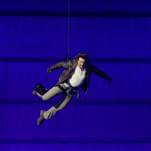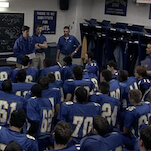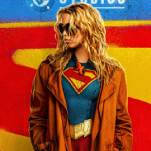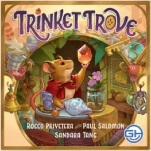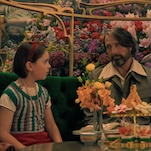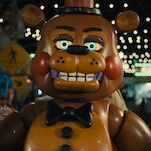It’s a scene out of an Oscar voter’s nightmare: During the climax of The Substance, an actress takes the stage, and rather than basking in the adoration of the crowd, sprays them with an absolute torrent of viscera; to call it a bloodbath would be an oversimplification of the variety of effluvia and the hoselike power with which it is expelled. Rather than recoiling, however, multiple high-profile branches of the Academy Of Motion Picture Arts And Sciences nominated the film at hand for their annual awards—not just in the field of makeup and hairstyling, but also honoring the film’s acting, directing, writing, and overall production. Between five nominations for The Substance and four nominations for the latest remake of Nosferatu, it’s a watershed year for bloodshed at the Academy Awards.
In sheer numbers, this isn’t the Academy’s best-ever showing for horror, if only because The Exorcist scored 10 nominations of its own among the films of 1973, winning one for Best Adapted Screenplay. But it’s rare to have not one but two high-profile horror movies in the Oscar mix, especially when neither title has much deniability as far as its genre is concerned. It’s easy enough to call The Silence Of The Lambs a thriller or a crime picture, and even easier to go with the high-minded description of Get Out as a “social thriller,” even though both are clearly also horror movies. But while a few have made the frankly nutty assertion that The Substance—which, just to clarify, features a youthful doppelganger emerging from a woman’s fleshy full-back opening, a monstrous transformation like something out of The Fly, and the aforementioned hydrant of gore, among other sights—is more satire than horror, directors Coralie Fargeat and Robert Eggers aren’t daintily fiddling with hints of genre elements in their Oscar-nominated films. Check the work that resulted in those makeup nominations again for proof.
The makeup category and other technical areas where Nosferatu racked up its nominations (cinematography, costumes, production design) also point to why, specifically, horror fans might feel frustrated by the lack of Oscar recognition in previous years. There are plenty of genres that aren’t particularly favored by the Academy, but so many classic horror movies excel in precisely the areas where that voting body is supposed to recognize superior craftsmanship: the sets, costumes, makeup, camerawork, and editing that all contribute to the atmosphere and thematic heft of great horror, and without the subtlety that might cause voters to ignore, say, precise editing in a comedy. Though of course there are horror novels and video games, the visual language of the genre feels uniquely, even obviously, cinematic in a way that can’t be so easily replicated in other media. Multiple versions of Dr. Jekyll And Mr. Hyde garnered various nominations in acting, writing, editing, and cinematography categories (with Fredric March even winning Best Actor for his dual performance in the 1931 Paramount version). But that seems like a minor concession given that early Universal horror movies like Dracula and Bride Of Frankenstein saw minimal awards attention; Bride managed a single nomination in the sound category. Granted, makeup and visual effects are fitting categories that were added too late to honor, say, Boris Karloff’s transformation into The Creature in the first two Frankenstein movies. But that didn’t need to preclude Karloff himself from consideration.
That’s long been the prestige paradox of horror movies: Whether lavish studio productions or shoestring indies, the best ones contain some of the most overt examples of pure Hollywood craft you could think of, all in service of what could be seen as the lowbrow work of frightening dumb teenagers. Given how much the Oscars seem to enjoy a feeling of importance—hence the number of showbiz-centric movies that seem to get extra credit for narratives that elevate the work of other entertainers—horror as a genre may prey on an industry-specific set of fears that a whole lot of these filmmaking skills can be poured into cheap thrills, shock tactics, and carnival tricks. Nosferatu resurrects a lot of those horror-craft categories as meticulous period-piece fodder, which makes it feel safer to honor than, say, the production design of The Texas Chain Saw Massacre, the score or cinematography of Halloween, or even the contemporary creepiness of the acting, writing, directing, and cinematography of Us. After all, the Academy wouldn’t want anyone getting the wrong idea about what it’s approving of here.
That’s also probably why The Substance seems to be resonating with Oscar voters, despite the lack of period trappings: Finally, a horror movie with the class to address how Hollywood beauty standards affect a wealthy and successful actress, rather than how less important fears affect a bunch of dumb normies! This is a little facetious; The Substance is great in part because of its discomfiting attention to the self-torturing psychology of beauty standards, rather than cleanly placing the blame solely somewhere easier and more comforting. (Also, it’s gnarly as hell.) For all of the movie’s shock value (and as funny as it is to picture the stereotypical Academy voter beholding this movie in all its too-much glory), the scene that might well win Moore the first horror-centric lead-performance Oscar since Black Swan contains zero torrents of guts, just a woman preparing for a date with a heartbreakingly laser-focused attention on her own supposed flaws. After all, what’s more Best Actress friendly than some good old-fashioned suffering?
But any accompanying resistance to fitting unruly horror films into those familiar award-circuit routines and traditions is why it’s possible to feel heartened by this year’s nine horror noms while still assuming that they represent a relative anomaly. And as delightful as it is to see a challenge to the Academy status quo (just as it was when The Shape Of Water, another one of those horror-deniability cases, flat-out won Best Picture), the anomaly may be preferable, or at least unavoidable, on some level. Drawing the audience in with gorgeous craft, like Nosferatu, or irresistible ideas made flesh, like The Substance, then bringing them right up to the edge of being disturbed, repulsed, or frightened away is arguably a fundamental horror technique; in that sense, the respectability of the Oscars is the natural (and mutual) enemy of the genre. Self-consciously “elevated” horror can be insufferable enough without the promise of awards-bait horror looking for prestige approval.
Fortunately, there’s still room for the disreputable, even as horror booms at the box office and the Oscars. Hell, the very same year as The Substance and Nosferatu, Ti West’s MaXXXine combined the approaches of both those films: It features a terrific lead performance from an actress playing an actress, who ties her self-worth up in cinema’s carnie-barker promise of eternal life, living through images rather than the humanity she sometimes seems hell-bent on defeating, and it’s also a visual feast with a wealth of nerdy period detail, including terrific costumes, hairstyling, production design, and practical (gore) effects. Obviously, it came nowhere near Oscar glory, and frankly, even the more dismissive reviews it received last summer felt a little like a relief. Mixed reviews can only boost its disreputability (especially crucial to a movie that’s not quite as sleazy as it could be). Similarly, would some of the unnerving wrongness of Longlegs be spoiled by giving Nicolas Cage a typical scene-stealing-villain consolation nom, even if his performance is singular enough to deserve it?
Of course, the Academy doesn’t need to be composed exclusively of anti-horror squares. As a horror fan, it’s gratifying, even surreal, when a textbook example of body horror becomes an awards-season favorite, or when what’s essentially a high-toned Universal monster movie gets recognized for the technical feats involved in conjuring such an enveloping mood. But it’s equally gratifying when a horror movie can marshal displays of Hollywood (or outsider) craftsmanship as impressive as any big-scale epic, only to make tastemakers flinch when it comes time to hand out high-minded prestige.




